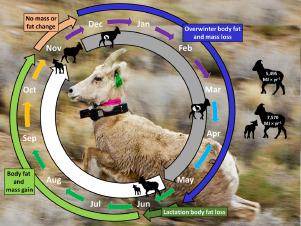当前位置:
X-MOL 学术
›
Ecol Modell
›
论文详情
Our official English website, www.x-mol.net, welcomes your
feedback! (Note: you will need to create a separate account there.)
State- and context-dependent applications of an energetics model in free-ranging bighorn sheep
Ecological Modelling ( IF 2.6 ) Pub Date : 2021-01-01 , DOI: 10.1016/j.ecolmodel.2020.109349 Kristin Denryter , David W. German , Thomas R. Stephenson , Kevin L. Monteith
Ecological Modelling ( IF 2.6 ) Pub Date : 2021-01-01 , DOI: 10.1016/j.ecolmodel.2020.109349 Kristin Denryter , David W. German , Thomas R. Stephenson , Kevin L. Monteith

|
Abstract Energy is fundamentally important to life and when energy supplies cannot support energy demands, animals may reduce energy deficits through behavioral compensation—a phenomenon that can vary with physiological state (state dependent) or environmental conditions (context dependent). We built an energetics model to estimate seasonal and annual energy expenditures by female Sierra Nevada bighorn sheep (Ovis canadensis sierrae; hereafter, Sierra bighorn) and evaluated whether energy expenditures by Sierra bighorn were consistent with behavioral compensation. We parameterized the model with values from the literature for energy expenditures for metabolism, feeding, locomotion, tissue synthesis, and reproduction in bighorn sheep and populated the model with empirical data (body mass, ingesta-free body fat, reproductive state, and daily movements) from female Sierra bighorn. Annual energy expenditures by reproductive females (7,182 MJ × yr−1) were ~42% greater than annual energy expenditures by non-reproductive females (5,066 MJ × yr−1). Regardless of reproductive state, female Sierra bighorn expended less energy on activity in winter compared with summer, which was consistent with context-dependent (environmental) behavioral compensation. Results for state-dependent behavioral compensation were ambiguous, but daily movements and associated energy expenditures decreased over winter, coincident with declines in body fat. Our energy model can be adapted to any free-ranging ungulate, if annual body mass and fat dynamics, metabolic rates, reproductive state, and daily movements are known. Coupling our model with estimates of food supplies may generate deeper insights regarding energetic motivations of migration and habitat use.
中文翻译:

能量学模型在自由放养的大角羊中的状态和上下文相关应用
摘要 能量对生命至关重要,当能量供应无法满足能量需求时,动物可能会通过行为补偿来减少能量缺乏——这种现象会随着生理状态(状态相关)或环境条件(上下文相关)而变化。我们建立了一个能量学模型来估计雌性内华达山脉大角羊(Ovis canadensis sierrae;以下简称大角羊)的季节性和年度能量消耗,并评估大角山脉的能量消耗是否与行为补偿一致。我们使用文献中关于大角羊的新陈代谢、进食、运动、组织合成和繁殖的能量消耗值对模型进行参数化,并用经验数据(体重、无摄入体脂肪、生殖状态、和日常运动)来自雌性 Sierra bighorn。生育女性的年能量消耗 (7,182 MJ × yr−1) 比非生殖女性的年能量消耗 (5,066 MJ × yr−1) 高约 42%。无论生殖状态如何,与夏季相比,雌性 Sierra bighorn 在冬季消耗的能量较少,这与上下文相关(环境)行为补偿一致。与状态相关的行为补偿的结果不明确,但日常运动和相关的能量消耗在冬季下降,与体脂下降相吻合。如果每年的体重和脂肪动态、代谢率、生殖状态和日常运动是已知的,我们的能量模型可以适用于任何自由放养的有蹄类动物。
更新日期:2021-01-01
中文翻译:

能量学模型在自由放养的大角羊中的状态和上下文相关应用
摘要 能量对生命至关重要,当能量供应无法满足能量需求时,动物可能会通过行为补偿来减少能量缺乏——这种现象会随着生理状态(状态相关)或环境条件(上下文相关)而变化。我们建立了一个能量学模型来估计雌性内华达山脉大角羊(Ovis canadensis sierrae;以下简称大角羊)的季节性和年度能量消耗,并评估大角山脉的能量消耗是否与行为补偿一致。我们使用文献中关于大角羊的新陈代谢、进食、运动、组织合成和繁殖的能量消耗值对模型进行参数化,并用经验数据(体重、无摄入体脂肪、生殖状态、和日常运动)来自雌性 Sierra bighorn。生育女性的年能量消耗 (7,182 MJ × yr−1) 比非生殖女性的年能量消耗 (5,066 MJ × yr−1) 高约 42%。无论生殖状态如何,与夏季相比,雌性 Sierra bighorn 在冬季消耗的能量较少,这与上下文相关(环境)行为补偿一致。与状态相关的行为补偿的结果不明确,但日常运动和相关的能量消耗在冬季下降,与体脂下降相吻合。如果每年的体重和脂肪动态、代谢率、生殖状态和日常运动是已知的,我们的能量模型可以适用于任何自由放养的有蹄类动物。











































 京公网安备 11010802027423号
京公网安备 11010802027423号